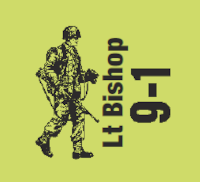
I often see questions asking how far a unit can move when carrying some Support Weapon. This seems to genuinely confuse people. In this article, I will discuss how to sort this all out, and highlight the table which takes all the guesswork out of the task. Let’s get started.
Rules Dive
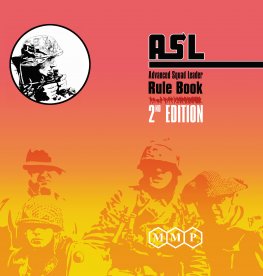
Every Good Order MMC has four Movement Factors (MF, A4.11) [EXC: Inexperienced]. Every Good Order SMC has six MF (A4.11). A Good Order MMC stacked with an SMC gains a two MF bonus [EXC: Inexperienced], allowing it six MF (see A4.12 for limits and conditions). Units may declare Double Time (A4.5) to gain an additional two MF bonus. This Double Time bonus stacks with a Leader bonus giving an MMC stacked with a leader up to 8 MF.
An MMC has an Inherent Portage Capacity (IPC) of 3 Portage Points (PP). An SMC has an IPC of 1 and can use this 1 IPC to help an MMC portage (carry) SW. Units portaging more than its IPC must give up one MF per PP in excess of its IPC. For example, an MMC carrying a 5 PP HMG has two MF available to it (4 MF – [5PP – 3 IPC] = 2 MF). An MMC carrying a 3 PP MMG has four MF available to it (4 MF – [3PP – 3 IPC] = 4 MF). A leader and an MMC carrying a 5 PP HMG has 5 MF available to it (4 MF + 2 MF leader bonus – (5 PP – 3 IPC – 1 PP [leader]) = 5 MF).
Now, a unit which declares Double Time (A4.5) also suffers Counter Exhaustion (A4.51, CX). A CX unit has an IPC one lower than normal, meaning an MMC has an IPC of two while a leader has an IPC of 0. Now our MMC carrying a 5 PP HMG, stacked with a leader declares Double Time. It has five MF available to it (4 MF + 2 MF leader bonus + 2 Double Time bonus – [5PP – 2 IPC – 0 PP [leader] = 5 MF).
The Chart
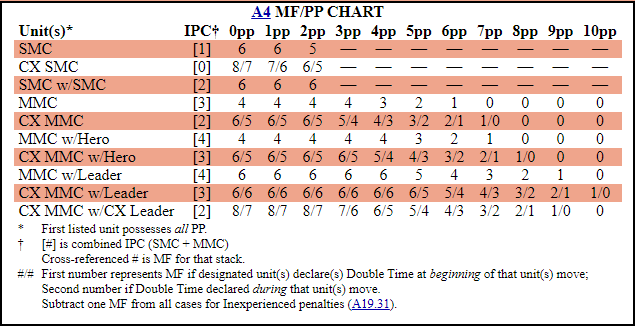
The chart above does all the math for you. In the left-hand column identify the units you have involved. Along the top row, identify the number of PP your units are carrying. The intersection of the row and column show the number of MF available to the stack. The number before the slash (“/”) shows the MF available if declaring Double Time from the start. After the slash is the MF available if declaring Double Time after spending MF (“Late Double Time”, A4.5).
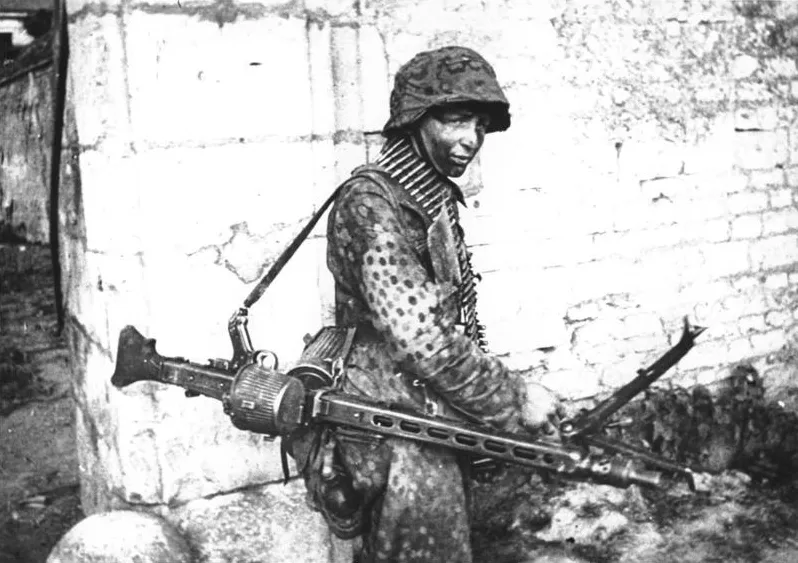
Let’s again consider our MMC carrying a 5 PP HMG stacked with a leader. The correct row is MMC w/Leader. We cross to the 5 PP column and see the stack has 5 MF, just as we calculated earlier.
But notice the row just below it, the CX MMC w/Leader. Again, the stack is carrying a 5 PP HMG but this time it has 6 MF and 5 if it declares a late Double Time. How does this work? The MMC stacks with a leader and declares Double Time giving it 8 MF. The MMC has a reduced IPC (2) but the leader can add its IPC (1) to the MMC’s. This means the MMC is 2 PP over the combined IPC. This reduces the 8 MF to 6, just as the chart says.
Moving Heavy Things Quickly
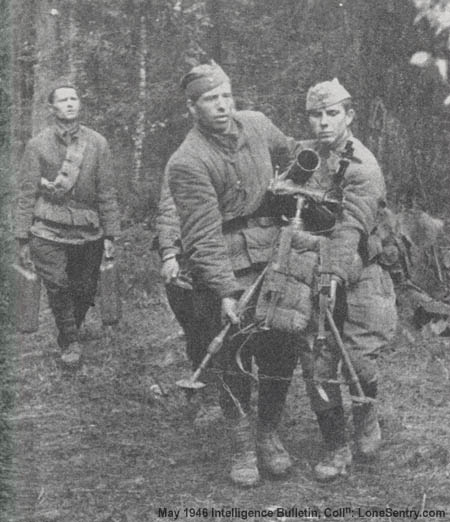
So this leads to the deployment “sleaze”. If the MMC possessing the HMG is a squad, deploy the squad. This leaves TWO MMC in the Location, one of which possesses the HMG. A squad and half-squad have the same IPC (3). Again, the MMC possessing the HMG declares Double Time, and again, the leader helps with its IPC. The MMC possessing the HMG has 6 MF but so do the leader AND the newly minted half-squad. The units move as a stack. In the APh, the CX MMC transfers the HMG to the non-CX MMC to avoid CX penalties. If the units remain in a stack, the next MPh, the new unit declares Double Time, the original unit loses CX status, and you can repeat the transfer process. You can do this turn after turn to portage heavy SW across the map.
Conclusion
I think understanding Infantry movement is essential to good game play. If you can’t work out the MF / portage point combinations in your head, then the chart is an absolute must. Even if you can work them out, the chart is nice to have. I am embarrassed to admit it took me far longer to find the chart than it should have. I hope my bringing it to your attention helps flatten your own learning curve. Until next time. – jim


Thanks for this one – short, but substantial. The chart is helpful!
Jim,
I have a question please.
My 9-2 was stacked with an 5PP HMG and squad (there’s a surprise). He wounds. I want to skulk. Is the calculation still (6MF with leader – 2 excess PP(5-3)) = 4MF. So even though the leader is wounded and cannot help carry the HMG and only has three MF the stack can skulk back to a building location and not be CX and then advance back into where it was and still not be CX?
Did I get it right?
I suppose the question can be summarised as even though the leader is wounded and can only move three MF he still gives the squad the potential to move six MF?
Many thanks for any help.
Joe
I am thinking yes, but that is a question worthy of a dive into Q&A or asking Perry. I can see the answer going either way. I have asked Klas. I am not sure what he will say. — jim
Klas thinks you played it correctly Joe. As you know, I am already with you too. Until someone submits a Q&A and the answer turns out otherwise, I will play it as you did. — jim
Jim – many thanks – and thank you for another great article.
Hi Jim, thanks for a very helpful piece on something we all think we know but maybe not as well as we should! The chart is particularly good.
I’ve occasionally had to remind people that if a leader accompanies two MMCs, each of which is carrying >3PP, he can only lend his 1 IPC support to one of them, not both.
Joe’s question is interesting. A17.2 last sentence says “A wounded leader’s two MF bonus for accompaniment throughout the MPh still applies”, so I’m guessing the answer is yes, but will of course see what Klas says. Also, presumably this means that if a wounded leader is himself being carried (cost 5PP), that MMC would have 4 MF available (or 5 with double time, even though the leader himself can’t)?
Thanks Andy. Klas and I chatted and he agrees with Joe’s take on it. The rules cover an MMC portaging a SMC. I haven’t looked in a while, but I know they can get the 2 MF bonus when they do. The SMC counts as 5PP though. — jim